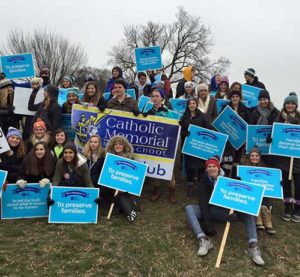 It seems that good news/bad news, is the order of the day.
It seems that good news/bad news, is the order of the day.
It is good news to hear from the pro-abortion Guttmacher Institute that the abortion rate in the United States has fallen to its lowest level since the infamous Roe vs. Wade decision of 1973. The bad news is that, in that same report (based on numbers for 2014, the most recent year available) there were at least 926,200 children aborted in the United States.
Good news is that the rate of abortions for women ages 15-44, is less than half what it was 35 years ago. Bad news is that minorities are so heavily targeted by the abortion industry, that they have abortion rates one and a half times greater among Hispanic women and two times greater for African-American women.

Catholic Memorial High School students gather in Washington D.C. last January prior to the start of the 2016 March for Life. (Submitted photo courtesy Fr. Paul Hartmann)
Good news is this weekend hundreds of thousands of people (most of them young people) will gather in Washington, D.C., in the hope of continuing the gains and the good news by participating in the annual March for Life. Bad news is that, with the exception of a few Catholic or conservative news outlets, most of America will hear nothing about the march.
Some have called the March for Life “America’s largest annual uncovered news event.” This weekend, continuing a tradition of 15 years, I will join the “Crusaders for Life,” Catholic Memorial High School’s pro-life club, and students from a number of schools in the area, who will attend this great sign of hope and commitment.
It has been estimated that since Roe vs. Wade there have been more than 56 million babies aborted in the United States. For students of college and high school age, when they realize that anywhere from a quarter to a third of their generation was never allowed to be born, some feel as compelled to act as others who might fight climate change, human trafficking, or any number of other social justice movements.
The good news is that as they realize that advocating for the unborn (the ultimate examples of defenseless persons, of dreamers wanting citizenship, of those truly insecure about nutrition and shelter), they are fighting for the most significant human rights issue of our time.
Beyond its direct attack on children in the womb, the most insidious impact of Roe vs. Wade has been in our culture’s skewed attitudes about sexuality; how we see the lives of others (the unborn, the disabled, the ill, the elderly) as mere encumbrances on the presumed “rights” or “freedoms” of an individual; and how we are being pushed to objectify aspects of life which were once defined as moral, miraculous and loving.
Ideally, these are matters of one’s soul. Instead, what should be a discernment of love, has been usurped as a debate of politics. What, by definition, makes us families or local communities of mutual support, has been degraded into oppositional rivalries and conflict more akin to mixed martial arts.
But we, as Catholics, always have a more hopeful vision. We have a matrix through which to understand the heart of the matter which is even more compelling than their being human rights. When Pope Francis visited the United States, he rightly pointed out that “care for one another is care for Jesus himself.” (Greeting to the Organizers, Volunteers and Benefactors of the World Meeting of Families, Sept. 27, 2015).
The matrix to which we should compare all of our supposedly “political” matters, and the vision of hope we are to have, are the same. It is our focus on Jesus Christ. When my group of CMH students travel to Washington, D.C., for the March for Life, they will be encouraged to engage in, and make possible, encounters with Christ.
Some might have stories of a sibling who might have been aborted because of Down syndrome. Some know firsthand that minorities are more likely the prey of the abortion industry. Some might know a college-aged friend or relative who was confronted with the decision for life. These students might bring about an encounter which will start the transformation of another person.
Others have never met an adult woman who survived a botched abortion attempt. Few have heard firsthand accounts of forced abortions of baby girls in many parts of the world. Rare is their encounter with a young man, born of rape, who challenges us not to see him first as a reminder of horror, but to first see conviction and inspiration which hopes to transform the world. These will be engagements with Christ at the March for Life.
By the time you read this, hopefully we will be in Washington, D.C. and getting ready for the 2017 March for Life. I ask your prayers for our safe travels. But, more importantly, I ask you to join us in the work of being pro-life. I ask you to join us as heralds of hope.
